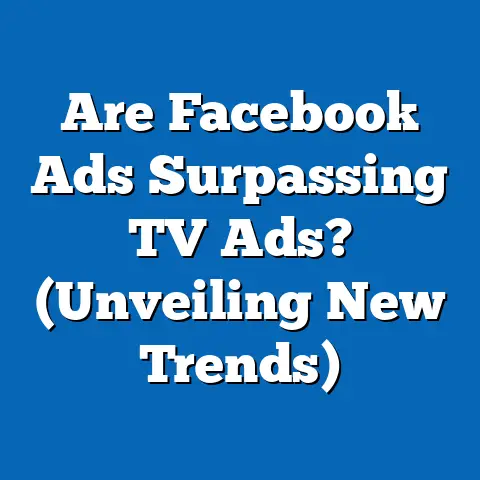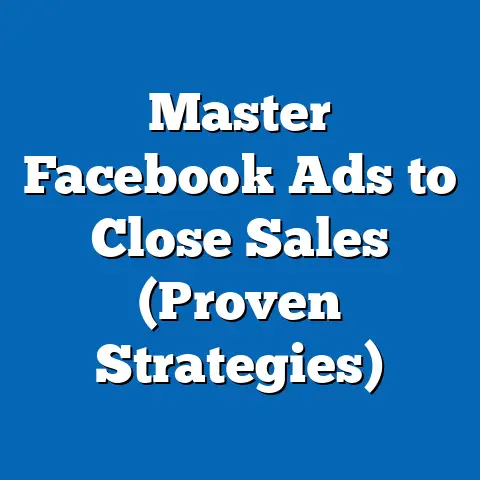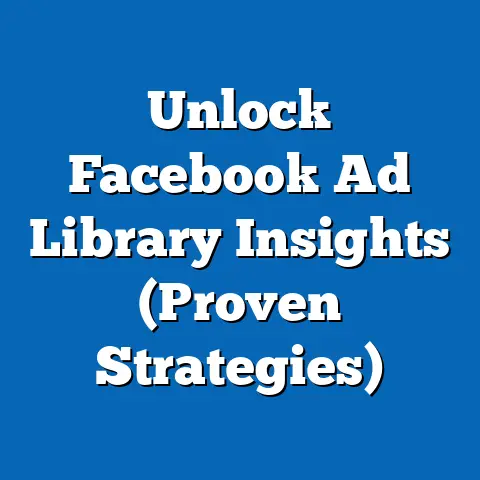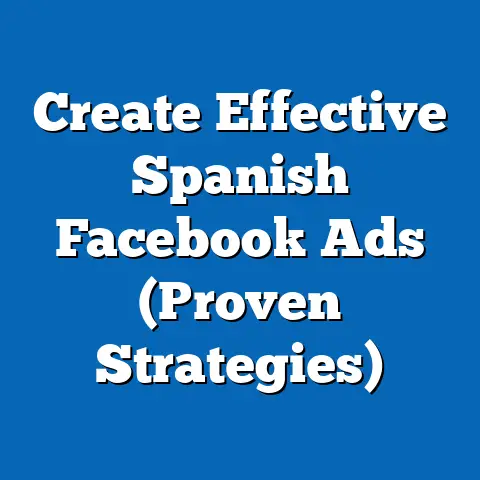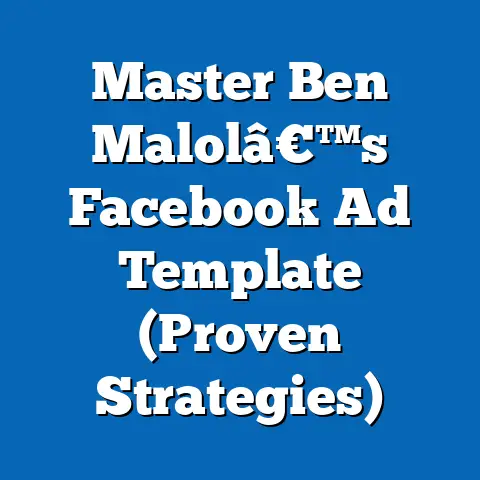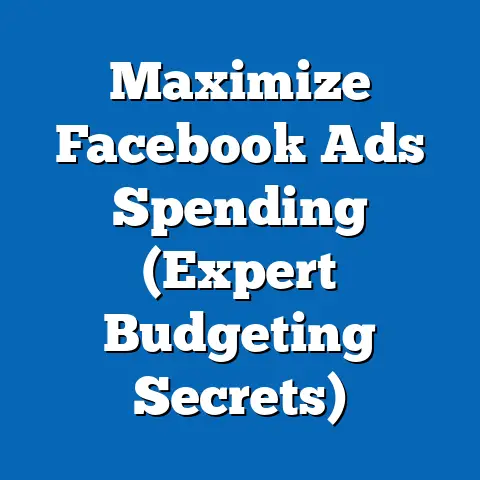Unlock Sales from Facebook Ads (Proven Strategies)
I’ve seen it countless times: a business owner, bright-eyed and full of hope, dives headfirst into Facebook advertising, only to emerge weeks later, wallet significantly lighter and ROI nowhere in sight. They’re throwing money at ads, but it feels like shouting into a void. The frustration is real – low conversion rates, campaigns that fizzle, and a gnawing feeling of being lost in a labyrinth of ad strategies that promise the world but deliver little. Does this sound familiar?
The truth is, Facebook, with its billions of active users, remains a powerhouse for driving sales. But, like any powerful tool, it needs to be wielded with precision and understanding. You can’t just throw money at it and expect magic to happen. That’s why I’m here to share proven strategies that can help you transform your Facebook ad spend into tangible revenue, unlocking the sales potential hidden within this vast platform. This guide will walk you through understanding the Facebook landscape, crafting compelling content, leveraging targeting options, and optimizing your ads for maximum impact. So, let’s dive in and turn those advertising frustrations into sales success stories!
Understanding the Facebook Advertising Landscape
Before you start crafting ads and setting budgets, it’s crucial to understand the playing field. Facebook advertising isn’t just about throwing up a pretty picture and hoping for the best. It’s a complex ecosystem with its own rules, nuances, and best practices.
Overview of Facebook Ads
Facebook offers a diverse range of ad formats, each with its unique strengths and weaknesses. Understanding these options is the first step to crafting effective campaigns. Here are a few of the most common types I use:
- Image Ads: These are the simplest form of Facebook ads, featuring a single image, headline, and description. They’re great for quickly conveying a message and are relatively easy to create.
- Video Ads: Video ads are incredibly engaging and can tell a more compelling story than static images. They’re perfect for demonstrating product features, sharing customer testimonials, or creating brand awareness. I’ve personally seen video ads achieve significantly higher engagement rates than image ads, especially when targeting younger demographics.
- Carousel Ads: Carousel ads allow you to showcase multiple images or videos in a single ad unit. This is ideal for highlighting different products, features, or benefits. They’re particularly effective for e-commerce businesses looking to showcase their product catalog.
- Collection Ads: Designed specifically for mobile shoppers, collection ads allow users to browse and purchase products directly from the ad. They feature a hero image or video, followed by a grid of product images.
- Lead Ads: Lead ads are designed to collect leads directly within the Facebook platform. They’re ideal for building email lists, offering free trials, or generating interest in your products or services.
Each ad format has its own advantages, so it’s important to choose the one that best aligns with your campaign goals and target audience.
Takeaway: Facebook offers a variety of ad formats. Understanding each format’s strengths will help you choose the right one for your campaign goals.
Target Audience Insights
One of the biggest advantages of Facebook advertising is its granular targeting capabilities. You can target users based on demographics, interests, behaviors, and more. But simply knowing these options exist isn’t enough. You need to truly understand your target audience – their needs, desires, and pain points.
Why is this so important? Because effective targeting leads to higher conversion rates. If you’re showing your ads to people who are genuinely interested in your product or service, they’re much more likely to click and convert.
I always start by creating detailed buyer personas. These are fictional representations of your ideal customers, based on research and data. Consider things like:
- Demographics: Age, gender, location, education, income, etc.
- Interests: Hobbies, passions, favorite brands, etc.
- Behaviors: Online activity, purchase history, device usage, etc.
- Pain Points: What challenges are they facing that your product or service can solve?
By understanding your target audience inside and out, you can craft ads that resonate with them on a deeper level, leading to higher engagement and ultimately, more sales.
Takeaway: Deeply understand your target audience. Create detailed buyer personas to guide your ad targeting and messaging.
Ad Placement and Algorithms
Facebook’s algorithms play a crucial role in determining which ads are shown to which users. Understanding how these algorithms work is essential for maximizing your ad’s visibility and engagement.
Facebook’s algorithm prioritizes ads that are relevant to users and provide a positive user experience. This means that ads with high engagement rates (likes, comments, shares) and low negative feedback (hides, reports) are more likely to be shown to a wider audience.
Ad placement also plays a significant role. Facebook offers a variety of ad placements, including:
- Facebook Feed: The most common and visible placement.
- Instagram Feed: Reach a different audience on Instagram.
- Facebook Marketplace: Target users who are actively shopping.
- Facebook Stories & Instagram Stories: Use engaging, short-form content.
- Audience Network: Extend your reach beyond Facebook to other apps and websites.
Each placement has its own advantages and disadvantages, so it’s important to test different placements to see what works best for your target audience.
Takeaway: Facebook’s algorithms prioritize relevant, engaging ads. Test different ad placements to optimize for visibility and engagement.
Crafting Compelling Ad Content
Now that you understand the Facebook advertising landscape, let’s talk about crafting compelling ad content that grabs attention and drives sales. Your ad is your salesperson, and it needs to be persuasive, engaging, and relevant.
Creating Attention-Grabbing Headlines
Your headline is the first thing people see, so it needs to be attention-grabbing and intriguing. Think of it as the bait that lures them in. Here are a few tips I’ve learned over the years:
- Keep it concise: Aim for a headline that’s short and to the point. People are scrolling quickly, so you need to capture their attention in a matter of seconds.
- Highlight the benefits: Focus on the benefits of your product or service, rather than just the features. What problem does it solve? How will it improve their lives?
- Create a sense of urgency: Use words like “limited time offer,” “act now,” or “don’t miss out” to encourage immediate action.
- Ask a question: Questions can be a great way to engage your audience and pique their curiosity.
- Use numbers: Numbers tend to stand out and can add credibility to your headline. For example, “5 Proven Strategies to Boost Your Sales.”
Clarity is paramount. A clever headline is useless if people don’t understand what you’re offering. A clear, concise headline that highlights the benefits and creates a sense of urgency is far more effective.
Takeaway: Your headline is the first thing people see. Keep it concise, highlight the benefits, and create a sense of urgency.
Visual Elements Matter
In the visual world of Facebook, your images and videos play a crucial role in capturing attention and conveying your message. High-quality visuals are essential for creating a positive first impression and encouraging clicks.
Here are some best practices I’ve found helpful:
- Use high-resolution images: Avoid blurry or pixelated images.
- Choose relevant visuals: Your visuals should be relevant to your product or service and appeal to your target audience.
- Use bright, eye-catching colors: Colors can evoke emotions and capture attention.
- Showcase your product in action: If you’re selling a product, show it being used in a real-life scenario.
- Use video whenever possible: Video is incredibly engaging and can tell a more compelling story than static images.
The key is to create visuals that are both aesthetically pleasing and relevant to your message. A stunning image that has nothing to do with your product will only confuse your audience.
Takeaway: Use high-quality, relevant visuals that capture attention and convey your message effectively.
Crafting the Perfect Call-to-Action (CTA)
Your call-to-action (CTA) is the final nudge that encourages people to take action. It’s the instruction that tells them what you want them to do next. A strong CTA can significantly increase your conversion rates.
Here are some tips for crafting effective CTAs:
- Use strong action verbs: Words like “Shop Now,” “Learn More,” “Sign Up,” or “Download” are clear and direct.
- Create a sense of urgency: Add a sense of urgency to your CTA by using words like “Today Only” or “Limited Time Offer.”
- Make it visually prominent: Your CTA should stand out from the rest of your ad. Use a contrasting color and a clear, easy-to-read font.
- Test different CTAs: Experiment with different CTAs to see what resonates best with your audience.
I’ve seen firsthand how a simple change in CTA can dramatically impact conversion rates. For example, changing “Learn More” to “Get Started Today” can create a greater sense of urgency and encourage more people to take action.
Takeaway: Your CTA is the final nudge that encourages people to take action. Use strong action verbs, create a sense of urgency, and make it visually prominent.
Leveraging Facebook’s Targeting Options
Facebook’s targeting options are incredibly powerful, allowing you to reach specific audiences with remarkable precision. Mastering these targeting options is key to maximizing your ad’s ROI.
Demographic Targeting
Demographic targeting allows you to reach users based on characteristics like age, gender, location, education, and income. This is a great way to narrow your audience and ensure that you’re showing your ads to people who are most likely to be interested in your product or service.
For example, if you’re selling skincare products specifically designed for mature skin, you can target women aged 40 and over. Or, if you’re promoting a local event, you can target people who live within a certain radius of the event location.
Demographic targeting is a fundamental tool for any Facebook advertiser. It’s the foundation upon which you build more sophisticated targeting strategies.
Takeaway: Use demographic targeting to narrow your audience and reach people who are most likely to be interested in your product or service.
Interest-Based Targeting
Interest-based targeting allows you to reach users based on their interests, hobbies, and passions. This is a powerful way to connect with people who are genuinely interested in what you have to offer.
Facebook gathers data on users’ interests based on their activity on the platform, including the pages they like, the groups they join, and the content they engage with. You can then use this data to target users who are interested in specific topics or brands.
For example, if you’re selling fitness equipment, you can target users who are interested in health and wellness, weightlifting, or yoga. Or, if you’re promoting a travel destination, you can target users who are interested in travel, adventure, or specific countries.
Interest-based targeting is a great way to reach a highly engaged audience and increase your chances of conversion.
Takeaway: Use interest-based targeting to reach users who are genuinely interested in your product or service based on their activity on Facebook.
Custom Audiences and Lookalike Audiences
Custom audiences and lookalike audiences are two of the most powerful targeting options available on Facebook. They allow you to reach your existing customers and find new customers who are similar to them.
- Custom Audiences: Custom audiences allow you to target users who have already interacted with your business, such as website visitors, email subscribers, or app users. This is a great way to retarget people who have shown interest in your product or service but haven’t yet converted. I’ve found retargeting to be one of the most effective strategies for driving sales.
- Lookalike Audiences: Lookalike audiences allow you to find new customers who are similar to your existing customers. Facebook analyzes the characteristics of your custom audience and identifies other users who share similar demographics, interests, and behaviors. This is a powerful way to expand your reach and find new customers who are likely to be interested in your product or service.
I’ve seen lookalike audiences consistently outperform other targeting options, particularly when targeting a high-quality custom audience.
Takeaway: Use custom audiences to retarget existing customers and lookalike audiences to find new customers who are similar to them.
Testing and Optimizing Your Ads
Facebook advertising is not a “set it and forget it” activity. To achieve optimal results, you need to continually test and optimize your ads based on data and performance.
A/B Testing
A/B testing, also known as split testing, involves creating two or more variations of your ad and testing them against each other to see which performs better. This is a powerful way to identify what resonates best with your audience and improve your ad’s effectiveness.
You can A/B test various elements of your ad, including:
- Headlines: Test different headlines to see which captures the most attention.
- Visuals: Test different images or videos to see which resonates best with your audience.
- CTAs: Test different CTAs to see which encourages the most clicks.
- Targeting: Test different targeting options to see which reaches the most engaged audience.
By systematically testing different variations, you can identify the winning combinations and optimize your ads for maximum performance.
Takeaway: A/B test different variations of your ad to see what resonates best with your audience and improve your ad’s effectiveness.
Analyzing Metrics
Monitoring key performance indicators (KPIs) is crucial for understanding how your ads are performing and identifying areas for improvement. Some of the most important metrics to track include:
- Click-Through Rate (CTR): The percentage of people who see your ad and click on it. A high CTR indicates that your ad is relevant and engaging.
- Conversion Rate: The percentage of people who click on your ad and complete a desired action, such as making a purchase or filling out a form. A high conversion rate indicates that your landing page is effective and your offer is compelling.
- Cost Per Acquisition (CPA): The cost of acquiring a new customer through your ad. A low CPA indicates that your ad campaign is efficient and cost-effective.
- Return on Ad Spend (ROAS): The revenue generated for every dollar spent on advertising. A high ROAS indicates that your ad campaign is profitable.
By tracking these metrics, you can gain valuable insights into your ad’s performance and identify areas where you can make improvements.
Takeaway: Monitor key performance indicators (KPIs) to understand how your ads are performing and identify areas for improvement.
Iterative Improvements
Facebook advertising is an ongoing process of testing, analyzing, and refining. You should continually refine your ad campaigns based on data insights and audience feedback to ensure ongoing success.
Don’t be afraid to experiment with new ideas and try different approaches. The Facebook advertising landscape is constantly evolving, so it’s important to stay up-to-date with the latest trends and best practices.
By embracing a mindset of continuous improvement, you can ensure that your Facebook ad campaigns are always performing at their best.
Takeaway: Continually refine your ad campaigns based on data insights and audience feedback to ensure ongoing success.
Real-World Success Stories
Theory is great, but seeing real-world examples can truly solidify your understanding. Here are a couple of case studies of businesses that have successfully leveraged Facebook ads to unlock sales:
Case Study 1: Local Boutique Clothing Store
- Challenge: A local boutique clothing store was struggling to attract new customers and compete with larger online retailers.
- Strategy: They implemented a Facebook ad campaign targeting women aged 25-45 within a 10-mile radius of their store, focusing on interest-based targeting related to fashion, style, and local events. They used carousel ads to showcase their latest arrivals and offered a 15% discount to first-time customers.
- Results: Within three months, they saw a 30% increase in foot traffic and a 20% increase in online sales. Their CPA decreased by 40% due to improved targeting and ad relevance.
Case Study 2: Online Subscription Box Service
- Challenge: An online subscription box service was struggling to acquire new subscribers and had a high churn rate.
- Strategy: They implemented a Facebook ad campaign targeting users interested in specific hobbies and interests related to their subscription boxes. They used video ads to showcase the contents of their boxes and offered a free gift with the first month’s subscription. They also used custom audiences to retarget website visitors and email subscribers who hadn’t yet converted.
- Results: Within six months, they saw a 50% increase in new subscribers and a 25% decrease in their churn rate. Their ROAS increased by 60% due to improved targeting and ad creative.
Lessons Learned:
- Targeting is Key: Both businesses saw significant improvements in their results by focusing on highly targeted audiences.
- Compelling Creative Matters: Using high-quality visuals and engaging ad copy is essential for capturing attention and driving conversions.
- Retargeting Works: Retargeting website visitors and email subscribers is a highly effective way to drive sales.
- Offer Incentives: Offering discounts, free gifts, or other incentives can encourage people to take action.
These success stories demonstrate the power of Facebook advertising when implemented strategically. By understanding your target audience, crafting compelling content, and continually testing and optimizing your ads, you can unlock the sales potential hidden within this vast platform.
Conclusion
Unlocking sales from Facebook ads requires a strategic approach that encompasses understanding the platform, crafting compelling content, leveraging targeting options, and continually testing and optimizing your campaigns.
To recap, we’ve covered:
- Understanding the Facebook Advertising Landscape: Knowing the different ad formats, the importance of target audience insights, and how Facebook’s algorithms work.
- Crafting Compelling Ad Content: Creating attention-grabbing headlines, using high-quality visuals, and crafting the perfect call-to-action.
- Leveraging Facebook’s Targeting Options: Utilizing demographic targeting, interest-based targeting, custom audiences, and lookalike audiences.
- Testing and Optimizing Your Ads: A/B testing different ad variations, analyzing key metrics, and making iterative improvements.
- Real-World Success Stories: Learning from the experiences of businesses that have successfully leveraged Facebook ads to unlock sales.
I encourage you to implement these proven strategies in your own Facebook advertising efforts. Remember, success is achievable with the right approach, and the potential rewards are significant. Don’t be afraid to experiment, learn from your mistakes, and continually refine your campaigns.
Now, I’d love to hear from you. What are your biggest challenges with Facebook advertising? What strategies have worked well for you? Share your experiences in the comments below and let’s learn from each other. Together, we can unlock the full potential of Facebook advertising and drive tangible results for our businesses. Let’s get the conversation started!

